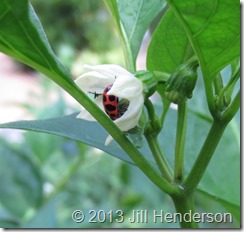By Jill Henderson – Show Me Oz -
Gardeners are always facing new and interesting challenges when it comes to pest management. The first line of defense includes correctly identifying the culprit so that the right measures can be taken to control it. I was recently talking to a fellow gardener about organic control of blister beetles on tomatoes when I happened to mention being cautious about using any kind of pesticide for fear of killing the pink ladybugs that have spent the last several weeks feasting on the pollen of nearby pepper plants. Her immediate response was that those pink ones were just another type of spotted cucumber beetle. I understand her confusion. I used to think that, too.
It isn’t surprising that my friend thought that these brightly colored insects were cucumber beetles of a different color. After all, they aren’t red and don’t have the classic high-domed wing covers like most other ladybugs have.
But like other ladybugs, the pink ladybug (Coleomegilla maculata), also known as pink-spotted lady beetle and twelve-spotted lady beetle, is an important beneficial in the garden, consuming many times its weight in garden pests such as aphids.
According to The Bug Guide, pink ladybugs eat a wide variety of insect pests, including “pea, green peach, melon (cotton), cabbage, and potato aphids and greenbug; eggs of European corn borer, imported cabbageworm, fall webworm, and corn earworm; asparagus beetle, Mexican bean beetle, and Colorado potato beetle eggs and larvae.”

Gardeners are always facing new and interesting challenges when it comes to pest management. The first line of defense includes correctly identifying the culprit so that the right measures can be taken to control it. I was recently talking to a fellow gardener about organic control of blister beetles on tomatoes when I happened to mention being cautious about using any kind of pesticide for fear of killing the pink ladybugs that have spent the last several weeks feasting on the pollen of nearby pepper plants. Her immediate response was that those pink ones were just another type of spotted cucumber beetle. I understand her confusion. I used to think that, too.
It isn’t surprising that my friend thought that these brightly colored insects were cucumber beetles of a different color. After all, they aren’t red and don’t have the classic high-domed wing covers like most other ladybugs have.
But like other ladybugs, the pink ladybug (Coleomegilla maculata), also known as pink-spotted lady beetle and twelve-spotted lady beetle, is an important beneficial in the garden, consuming many times its weight in garden pests such as aphids.
According to The Bug Guide, pink ladybugs eat a wide variety of insect pests, including “pea, green peach, melon (cotton), cabbage, and potato aphids and greenbug; eggs of European corn borer, imported cabbageworm, fall webworm, and corn earworm; asparagus beetle, Mexican bean beetle, and Colorado potato beetle eggs and larvae.”

In this way pink ladybugs are very similar to other ladybugs, except that as much as 50% of their diet comes in the form of pollen obtained from flowers such as dandelion, cucumber, squash, and in my garden, peppers.
Perhaps it is a coincidence, but for the last few years we have had large populations of pink ladybugs in our garden. They seem to arrive several weeks after the spotted cucumber beetle, which of course, feeds on the leaves, stems and flowers of cucurbits such as squash, melons and cucumbers.
With the pink ladybug’s preference for pollen, I often find them on the very same plants that the cucumber beetles are feasting on. With squash being one of the preferred flowers, it makes sense that both pink ladybugs and spotted cucumber beetles would be on the same plant at the same time. After all, cucurbits have the largest, showiest and most prolific flowers in the summer garden. What pollen-loving insect in its right mind wouldn’t be interested?
Yet, while both insects feed on the flower pollen – which increases pollination rates and doesn’t hurt the flowers – cucumber beetles feed primarily on the leaves and stems. Their insatiable feeding causes irreparable harm to foliage, transmits bacterial wilt, and spreads powdery mildew in the process.

Perhaps it is a coincidence, but for the last few years we have had large populations of pink ladybugs in our garden. They seem to arrive several weeks after the spotted cucumber beetle, which of course, feeds on the leaves, stems and flowers of cucurbits such as squash, melons and cucumbers.
With the pink ladybug’s preference for pollen, I often find them on the very same plants that the cucumber beetles are feasting on. With squash being one of the preferred flowers, it makes sense that both pink ladybugs and spotted cucumber beetles would be on the same plant at the same time. After all, cucurbits have the largest, showiest and most prolific flowers in the summer garden. What pollen-loving insect in its right mind wouldn’t be interested?
Yet, while both insects feed on the flower pollen – which increases pollination rates and doesn’t hurt the flowers – cucumber beetles feed primarily on the leaves and stems. Their insatiable feeding causes irreparable harm to foliage, transmits bacterial wilt, and spreads powdery mildew in the process.

Because pink ladybugs often show up on the same plants at the same time as cucumber beetles, they are often simply mistaken as another type of cucumber beetle. As a result, many pink ladybugs are erroneously eradicated every year by both chemical and natural insecticides.
As much as we organic gardeners love our good bugs, not all ladybugs are greeted warmly. The Asian ladybug (Harmonia axyridis) is well-known as an invasive species that congregates by the thousands on and into homes and buildings during the winter. Anyone who has never had a ladybug invasion would be well-advised not to hope for one. These non-native species has a proclivity to bite and they exude a yellow secretion that smells and stains walls, clothes and hands. For more information on Asian ladybugs and ladybugs in general, check out my article, Ladybug, Ladybug….
On the other hand, pink ladybugs are good guests who never bite the gardener that grows their flowery food and always flies home when the season is over.
Please check out these great informative sites for more info on Pink Ladybugs and tell them Show Me Oz sent you!
As much as we organic gardeners love our good bugs, not all ladybugs are greeted warmly. The Asian ladybug (Harmonia axyridis) is well-known as an invasive species that congregates by the thousands on and into homes and buildings during the winter. Anyone who has never had a ladybug invasion would be well-advised not to hope for one. These non-native species has a proclivity to bite and they exude a yellow secretion that smells and stains walls, clothes and hands. For more information on Asian ladybugs and ladybugs in general, check out my article, Ladybug, Ladybug….
On the other hand, pink ladybugs are good guests who never bite the gardener that grows their flowery food and always flies home when the season is over.
Please check out these great informative sites for more info on Pink Ladybugs and tell them Show Me Oz sent you!


Nenhum comentário:
Postar um comentário